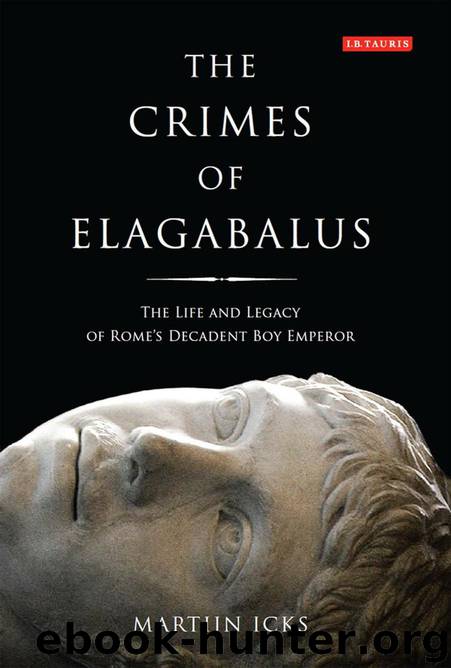The Crimes of Elagabalus: The Life and Legacy of Rome's Decadent Boy Emperor by Martijn Icks

Author:Martijn Icks [Icks, Martijn]
Language: eng
Format: epub
Published: 2016-01-22T16:00:00+00:00
THE ‘EVIL TYRANT’: SELECTED WORKS
Elagabalus in Aureli and Cavalli’s Eliogabalo (1667)
Francesco Cavalli (1602–76) was one of the greatest opera composers of his time. When the impresario of the SS. Giovanni e Paolo theatre in Venice commissioned him to write the score for Eliogabalo, another success seemed imminent. The libretto of the opera, due to be put on stage in the Venetian carnival season of 1667–68, was written by Aurelio Aureli (ca. 1630–ca. 1708), one of the city’s foremost librettists. Aureli’s text – itself the revision of the text of an anonymous author – recorded the last days of the ‘evil’ emperor Eliogabalo, whose bad reign and selfish intrigues led to his murder and the ascent of his noble and virtuous successor, Alessandro. Like many of Aureli’s plots, Eliogabalo was inspired by historical events, but did not stay true to its sources, elaborating on them and changing them into something substantially different. Nevertheless, it is evident that its ‘historical’ core was ultimately based on the Historia Augusta, which provides the opera with many specific scenes and details. Aureli did not read the Vita Heliogabali directly, but used the Italian translation of Pedro Mexía’s Historia imperial y cesarea (1545), a Catalan work which borrowed from the Historia Augusta.²¹
The result of Cavalli’s and Aureli’s combined efforts did not please Giovanni Carlo and Vincenzo Grimani, who owned the SS. Giovanni e Paolo theatre. These two young brothers – 19 and 15 years old respectively – abruptly fired the theatre’s impresario in 1667 and took matters into their own hands. They dismissed Cavalli and replaced him with Giovanni Antonio Boretti, a much younger composer, who wrote an entirely new score for the piece. Aureli was ordered to make some revisions to the text. It was this second version of Eliogabalo which was eventually performed, while Cavalli’s original score was never heard in the opera houses of Venice.²² The reasons for this are not entirely clear. Cavalli’s musical style may simply have gone out of fashion, but this begs the question why the composer was hired in the first place.
In this chapter, we will concern ourselves with Aureli’s original, unrevised libretto for Eliogabalo. The plot of the opera is constructed around emperor Eliogabalo’s amorous escapades. After he has raped the noblewoman Eritea, the lustful ruler sets his eye on Flavia Gemmira, the fiancée of his virtuous cousin Alessandro. Eliogabalo makes several attempts to murder Alessandro and seduce Flavia, but does not succeed in either goal. Moreover, the emperor is unaware that his escapades have invoked the anger of his praetorian prefect, Giuliano, who is Flavia’s brother and Eritea’s lover. Giuliano wants to kill Eliogabalo, but is stopped by Alessandro, who argues that only heaven is allowed to punish a sinner. Eliogabalo still meets with a deservedly gruesome end when he tries to rape Flavia and is killed by his own soldiers. Alessandro succeeds him and takes Flavia as his empress. On this happy note, the opera ends.
Aureli leaves his audience in no doubt that Eliogabalo is the villain of the piece.
Download
This site does not store any files on its server. We only index and link to content provided by other sites. Please contact the content providers to delete copyright contents if any and email us, we'll remove relevant links or contents immediately.
| France | Germany |
| Great Britain | Greece |
| Italy | Rome |
| Russia | Spain & Portugal |
Fanny Burney by Claire Harman(25792)
Empire of the Sikhs by Patwant Singh(22185)
Out of India by Michael Foss(16315)
Leonardo da Vinci by Walter Isaacson(11920)
Small Great Things by Jodi Picoult(6108)
The Six Wives Of Henry VIII (WOMEN IN HISTORY) by Fraser Antonia(4800)
The Wind in My Hair by Masih Alinejad(4428)
The Lonely City by Olivia Laing(4127)
The Crown by Robert Lacey(4115)
A Higher Loyalty: Truth, Lies, and Leadership by James Comey(4041)
The Iron Duke by The Iron Duke(3652)
Millionaire: The Philanderer, Gambler, and Duelist Who Invented Modern Finance by Janet Gleeson(3576)
Sticky Fingers by Joe Hagan(3457)
Alive: The Story of the Andes Survivors by Piers Paul Read(3320)
Papillon (English) by Henri Charrière(3280)
Joan of Arc by Mary Gordon(3271)
Stalin by Stephen Kotkin(3091)
Aleister Crowley: The Biography by Tobias Churton(3026)
Ants Among Elephants by Sujatha Gidla(2928)
